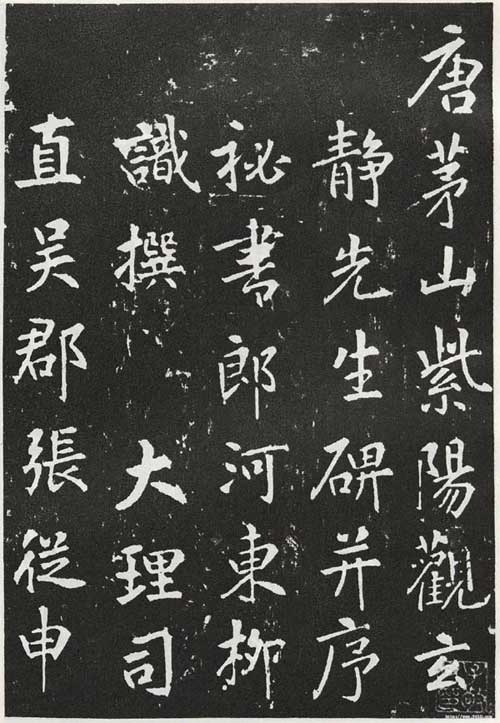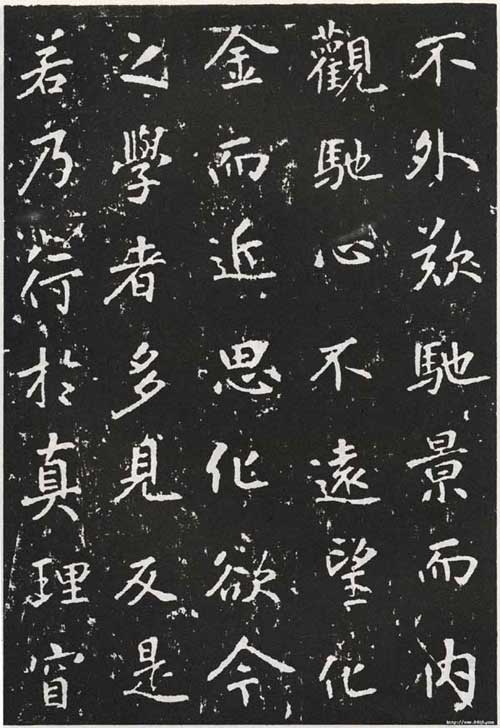A native of Wu County in the Tang Dynasty, he was promoted to the rank of Jinshi, a doctor in the School of Etiquette, and the second king of calligraphy. Li Yangbing mostly writes inscriptions on his book monuments, and the titles of his books are higher. Dou Meng's note in "Shu Shu Fu·Part 2" written by Dou Xuan of the Tang Dynasty says: "Cong Shen Zhiye is extremely good at running calligraphy. He holds the pen tightly and has tight knotting of characters, which is unprecedented in recent times. I hate that I have not read much, and I have heard and seen very few." "The Continuing Book Commentary" by Mr. Lu of the Tang Dynasty said that Cong Shenzhen and Xingshu were "praised as beautiful from far and near, and unique outside the Yangtze River". Zhu Changwen of the Song Dynasty listed his books in the "Sushu Duan" volume, and Huang Bosi of the Song Dynasty "Dongguan Yulun" said: "Although I learned from Youjun (Wang Xizhi) from Shen Shu, its origins are from the Great Order (Wang Xianzhi), and the writing style is the same as that of Li Beihai (Li Yong) is from the same department, and his reputation is important for a while, so he deserves it, but his shortcomings are that he is too restrained and low-spirited, and he is really not as good as Xinger. However, the people of the Tang Dynasty have Jin rhyme, which is worthy of praise." Ming Xiang Mu "Calligraphy Yayan·Zhengqi" says that Congshen's "writing style is absolutely like Beihai". Feng Ban of the Ming Dynasty's "Bi Yin Shu Yao" said: "Zhang's book is very ancient, and people who are ignorant do not know its beauty." Qing Liang's "Pingshu Tie" said that Zhang Congshen "opened the book with great orders, and kept the original rate up to date (Ouyang Xun). However, the books are often stiff and not as soft as Beihai Jinjian Zhongrao." Zhu Lvzhen of the Qing Dynasty commented on his calligraphy in the second volume of "The Essentials of Calligraphy" as "the strokes are heavy and steep, and the style is sparse and sparse". The handed down writings include the "Li Xuanjing Stele", the "Wang Shiqian Shinto Stele", the "Lawyer Shen Stele", the "Renovated Wu Yanling Jizi Temple Stele", and the "Tongya Town Fuxing Temple Stele". His younger brother Congshi, Congyi, Congyue and Gongshu were known as the "Four Dragons of the Zhang Family" at that time (see Zhang Congshen's entry in "Chinese Calligraphy Dictionary" written by Liang Piyun). Zhang's calligraphy inherited Youjun's calligraphy style. "Li Xuanjing Stele" is the most famous one in Zhang's calligraphy. It is very famous in Tang Xingshu, and its rubbings are rarely circulated. Looking at the calligraphy on this stele, the writing is sharp and vigorous, and the structure is similar to the "Preface to the Holy Religion of the Collection of Kings", which is said to be "the style of the right army, and the writing is there."
Appreciation of works: "Li Xuanjing Monument"


"Li Xuanjing Stele" (written by Zhang Congshen) is also called "Mr. Xuanjing Li Hanguang Stele", and its full name is "Mr. Inscribed on August 14th, the seventh year of Dali (772), Emperor Daizong of the Tang Dynasty, it was written by Liu Shi, written by Zhang Congshen, and sealed by Li Yangbing. The stele was originally in Yuchenguan, Jurong, Jiangsu. It was destroyed by fire in the third year of Jiajing reign of Emperor Shizong of the Ming Dynasty (1529). The rubbings handed down from ancient times are very rare, and no complete paper version has been found. There are 835 characters in total, and the number of lines of the original stele is unknown. .
The "Li Xuanjing Stele" records the life and deeds of Li Hanguang, a Taoist priest in Liyangguan, Maoshan, Tang Dynasty. Li Xuanjing (683-769), whose given name was Hanguang and whose real name was Hong, was changed to Li to avoid the taboo of Prince Gaozong Li Hong. He was the fifth generation descendant of Tao Hongjing of the Shangqing sect of Immortal Taoism. He was highly praised by Xuanzong and was the famous Taoist priest with the most followers in both the government and the public at that time. Li Xuanjing himself was also proficient in calligraphy. Yan Zhenqing said in "Li Xuanjing Stele" that he was "very good at seal script, and especially good at official script." In the Tang Dynasty, everyone in Buddhism and Taoism was extremely proficient in calligraphy. This was necessary for copying scriptures and entertainment. Therefore, Buddhist and Taoist calligraphy became very popular and had many contacts with secular calligraphers. There are also Taoists who are good at calligraphy, such as Lu Xuanqing, a Taoist priest from the Taiqing Palace. Quan Deyu's "Taizong Feibai's Reply to the Imperial Edict" states that "Gong is a seal and official eight-point book, which has its own family method." There are also Yu Youxuan and Liang Yuanyi. Volume 10 of "Xuanhe Shupu" says: "(Taoist Yu Youxuan) Gongxingshu has Wang Xi's style of writing, and its freshness does not fall into the worldly habits. It has the spirit of immortality and Taoism. You can imagine the person." Comments on Volume 5 say :" (Taoist Liang Yuanyi) was particularly fond of calligraphy. He first admired Zhong and Wang Kaifa, and for a long time he went outside the rules. However, his method is strict, his spirit is relaxed, and his style is clear... Take a look at his book "Tai Shang Nei Jing Jing" , The writing of small regular script is both body and good, and it is beyond the reach of people who know the world." Li, Lu, Yu, and Liang, although they have been famous for thousands of years, they are deeply respected by future generations. However, it is regrettable that a piece of paper from the Yuan Dynasty was left in the world (see Zhu Guantian's "History of Chinese Calligraphy: Sui, Tang and Five Dynasties Volume"). Today we can only get a glimpse of Li Xuanjing's style from the articles written by Liu Shi (alias Fang Ming, Gong Wen Zhang).
Although the writing style of this stele comes from the "Preface to the Holy Religion", its softness is one part and its simplicity is one part strong. The so-called clean and sharp strokes, short strokes with long meanings, and seeking the right direction for the rise and fall of the strokes, in order to obtain the air of ease, appear strong and neat, ancient and vigorous, there is "painting can be as clean as blond hair, and white hair can be as large as a jade ruler" "Qi" (Qing Da Chongguang's "Shu Raf") is wonderful. The body is slightly sparse, with twists and turns. It is round and soft in the square and sharp, and graceful in the strictness. It is very reminiscent of Ouyang Xun's legacy. The first half of this stele is written in a strict manner, while the second half is relaxed, with wonderful opening and closing changes. The calligraphy of the Tang Dynasty was a period of great reorganization in terms of brushwork, brushwork, and physical structure. It was a redefinition of the inherent factors of the complicated calligraphy of the previous dynasties. They are all elegances and improvements to the official script of Beibei. Similarly, Zhang Congshen also did the same work from the perspective of running script with "The Preface to the Collection of Kings and Saints", but he did not achieve special success. However, Yan Zhenqing started from the seal method to transform running script, created a unique style, and finally reached another peak of Chinese running script. This can only be said to be the difference in the calligraphers' insights and methods that led to different results.
The main records of this stele include: Song Ouyang Xiu's "Postscript to the Collection of Ancient Records", Ouyang Pei's "Collection of Ancient Records", Huang Bosi's "Remaining Comments on Dongguan", Chen Si's "Bao Ke Congbian", Li Guangying's "Guanmiao Zhai Zang" in the Qing Dynasty "A Survey of Epigraphy", Yan Guan's "Jiangning Epigraphy", Fang Lu's "Epigraphy Collection and Supplement", He Shaoji's "Dongzhou Caotang Epigraphy Postscript", modern Luo Zhenyu's "Xuetang Epigraphy Postscript", etc.
This rubbing from the Yuan Dynasty has exquisite felt wax and the paper and ink are authentic. It was once collected by Mr. Zhu Yigai of Xiaoshan. In 1953, Mrs. Zhu Zhang Xianzhi and her son donated it to the Palace Museum.
According to Wang Zhuanghong's "Essays on Supplementing the School Stele", the versions seen are:
1. Rubbings from the Song Dynasty inscribed by King Juesi in the Palace Museum, Beijing. (actually Yuantuo)
2. Song rubbings from the old collection of Wu Yun in Gui'an, Beijing Library, with inscriptions by Zhang Zhao, Mao Huai, He Shaoji, Wu Rangzhi, Mo Youzhi, Xu Naizhao, Li Hongyi and others.
3. An old copy collected by Zhang Shuwei. This copy is lacking space and has a slightly late rubbing. There is a lithographic copy in Zhengshu.
4. Song rubbings from Qu Liangshi's old collection, including Gong Zizhen's postscript, which were photocopied on metal plates by the Commercial Press. In addition, I heard that the Shanghai Library has a copy, but I have not seen it. (Photocopied and published by Shanghai Ancient Books Publishing House)
5. In 1935, Ouyang Futai, who collected ancient Shanfang seals in Jiangxi Province, titled it "Jintuo of the Northern Song Dynasty" and actually reproduced it.
[Note] The copy in the Shanghai Library is a rubbing from the Song Dynasty. The writing is intact, but the inscription is missing. The seals include "a rare treasure of the world", "Dingfu's examination and approval", "Yue Zao ", "Bingheng's private seal", "Yuan Chun's seal", "descendants Shishou" and "Pingyuan uncle Gufu's treasure". This volume has a total of 26 and a half pages, with a height of 38.7 cm and a width of 24.8 cm . The inscription is sixteen and a half open, the core is 27 centimeters high and 15.6 centimeters wide.








